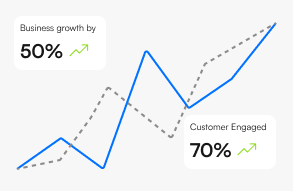Understanding Conversational AI with Examples

Namrata Chakraborty
April 05, 2024
7 min

Table of Contents
Amidst the incredible array of technological innovations, one stands out for its ability to bridge the gap between humans and machines – Conversational AI. From simplifying everyday tasks to transforming entire industries, Conversational AI has become the cornerstone of modern interaction.
Experts predict that the conversational AI market will generate USD 41.39 billion revenue by 2030. This exponential growth is fueled by the increasing demand for seamless human-machine interactions across various sectors, ranging from retail and finance to healthcare and enterprises.
In this blog, we explore some examples of conversational AI and illustrate its versatility and impact across different domains.
Examples of Different Types of Conversational AI
Conversational AI comes in various shapes and forms. The following three are the most common types of conversational AI:
1. Chatbots
Chatbots stand as one of the most pervasive manifestations of conversational AI, seamlessly integrating into various digital platforms, including websites, messaging applications, and social media channels. Data shows that sales and customer service-oriented businesses, especially in the insurance and finance sector, could potentially save $174 billion by using chatbots.
The rapid adoption of chatbots across every industry vertical is much due to the easy access of the chatbot technology. Custom AI chatbot builder tools like Thinkstack allow users to build their own chatbots without the need of any coding knowledge. These tools can be used by small businesses to large enterprises for building brand-specific personalized bots that act as a part of the company’s trained workforce.
Examples of conversational AI chatbots:
- Open AI’s ChatGPT
- Bank of America's Erica
2. Voice Assistants
Voice assistants stand out as another prime example of Conversational AI. These voice chatbots excel in providing natural language interaction through spoken commands, offering a hands-free and intuitive user experience. They are particularly useful in situations where users require quick access to information or services without the need for manual input, such as in smart home control or while driving.
For instance, users can effortlessly obtain weather updates, organize appointments, or even shop for groceries through simple voice commands.
Examples of voice assistants:
- Amazon’s Alexa
- Apple’s Siri
- Google’s Google Assistant
3. Virtual Assistants
Virtual assistants offer more multi-modal interactions, allowing users to seamlessly switch between voice commands, text input, and touch-based interactions across different devices and platforms. They are more functionally holistic and their conversational AI capabilities are stronger and therefore more personalized.
For instance, some virtual assistants offer advanced features like language translation, image recognition, sentiment analysis, and personalized recommendations based on user behavior and preferences.
These types of conversational AI bots can perform a wide variety of tasks, from conducting web searches and controlling smart home devices to setting reminders and managing calendars.
Examples of AI virtual assistants:
- Microsoft's Cortana
- IBM's Watson Assistant
5 Real-Life Examples of Conversational AI in Different Industries
Thanks to its unparalleled accessibility, conversation AI technology has permeated nearly every business sector. Platforms like Thinkstack empower businesses to effortlessly utilize their existing resources, such as knowledge bases and guidelines, to create multiple chatbots— each customizable to perform various tasks while adhering to the organization’s brand guidelines.
In just one day, these resources can be harnessed to train and personalize chatbots, seamlessly integrating them into the organization’s workforce fabric.
Here are some examples showing how conversational AI chatbots can be used in different industries for different purposes.
Example 1: U.S. Bank’s ‘Smart Assistant’
- Industry: Banking and finance
- Use Case: Customer Support
- Bot type: Virtual Assistant
The U.S. Bank Smart Assistant is an innovative personal banking tool designed to enhance the banking experience for the U.S. Bank customers. Leveraging artificial intelligence and machine learning technologies, this smart assistant provides personalized financial guidance, assistance with account management, and access to banking services through natural language interactions.
It can perform a variety of financial tasks:
- analyzes a customer's spending patterns and account history
- perform various banking tasks, such as checking account balances, transferring funds between accounts, and paying bills
- advice on budgeting, saving, investing, managing debt, and more.

Recommended Article: Conversational Banking— Shaping the Future of Finance
Example 2: Amtrak’s Julie
- Industry: Travel & Tourism
- Use Case: Customer Support
- Bot type: Chatbot
One real-life example of conversational AI being used by companies to handle large-scale customer inquiries and provide support is Amtrak, the national passenger railroad service in the United States.
Amtrak employs a chatbot called “Julie” on its website and mobile app to assist customers with a variety of inquiries, including ticket bookings, train schedules, route information, fare details, and travel policies. Customers can interact with Julie using natural language through a chat interface, asking questions and receiving instant responses.
On an average day, Amtrak’s Julie responds to 50,000 calls per day. After the deployment of this conversational AI bot on their website, Amtrak noticed a 53% increase in their customer satisfaction.
Julie is one of the best examples that demonstrate how conversational AI is widely utilized by companies to handle customer inquiries, provide support, and offer troubleshooting guidance across digital channels such as websites and mobile apps.
Example 3: Buoy Health’s AI Symptom Checker
- Industry: Healthcare
- Use Case: Symptom checker
- Bot type: Chatbot
Buoy Health is an example of a conversational AI-powered medical assistant designed to help users assess their symptoms and find appropriate healthcare resources. Users can interact with Buoy through a chat interface where they describe their symptoms and answer an elaborate list of questions. Buoy uses natural language processing and machine learning algorithms to analyze the information provided and generate personalized recommendations.
For instance, if a user describes symptoms such as fever, cough, and fatigue, Buoy might ask follow-up questions to gather more details, such as the duration of symptoms and any underlying health conditions. Based on this information, Buoy can provide advice on whether the user should seek immediate medical attention, schedule a doctor’s appointment, or try home remedies.
Example 4: Lemonade Bots (‘Maya,’ ‘Jim,’ and ‘CX.AI.’)
- Industry: Insurance
- Use Case: Customer onboarding, customer support, and claim processing
- Bot type: Chatbot
Lemonade, a digital insurance company founded in 2015, has gained significant attention for its innovative approach to insurance services, including the integration of conversational AI technology to enhance customer interactions.
It has not one, but three unique chatbots named Maya, Jim and CX.AI to help its customers with different activities.
Maya is an example of conversation AI used for customer onboarding. Its personality is more ‘charismatic’ and it helps Lemonade customers with the enrollment process, generating quotes, and ensuring secure payment processing.
AI Jim serves as Lemonade’s claims bot, handling initial claims processing with minimal human intervention. With a 98% success rate in autonomously managing claims, AI Jim triages and assigns claims to human experts. An interesting fact is that before transferring to humans, this chatbot analyzes experts’ specialties, qualifications, and workload.
CX.AI is Lemonade’s customer support chatbot that manages 27% of customer inquiries autonomously. Notably, this conversational AI’s efficiency is exemplified in its ability to seamlessly handle tasks like policy transfers during customer relocations, completing processes in seconds.
Example 5: H&M’s KIK Bot
- Industry: Retail
- Use Case: Customer Support
- Bot type: Chatbot
Popular clothing and apparel brand H&M introduced a chatbot on KIK, a messaging app widely used by American teenagers. This conversational AI bot provides instant outfit inspiration. Users can interact with it to create fashionable looks by specifying a piece of clothing (like joggers, jeans, tops, or shirts), and the chatbot will build an outfit around it.
Additionally, the chatbot engages users with personality quizzes related to style. It also integrates shopping features, allowing users to see, share, and purchase products directly from H&M’s catalog.
Take a look at this video to see how it works:
Wrapping it Up
The future is artificial intelligence. I say, give it a few years and AI will be as indispensable and naturally integrated into our lives like our very own heartbeats. From the above examples, one thing is clear: conversational AI can optimize your business and it is not a trend that will pass, it is a necessity for any business to stay afloat in the competition. The question now: what should be your next step?
Do you want to improve your business with conversational AI, but don’t know where to start? A really good starting point is to try our free chatbot maker. Sign up without the hassle of any credit card details and see how it works for you.
To schedule a quick demo or ask any questions, reach out to our cheerful and enthusiastic sales team on our Contact Us page.

Grow Your Business with AI Chatbots
- Automate tasks
- Engage customers 24/7
- Boost conversions